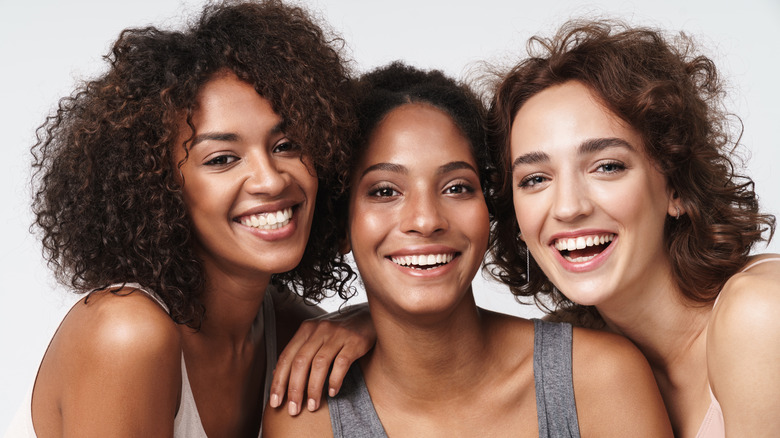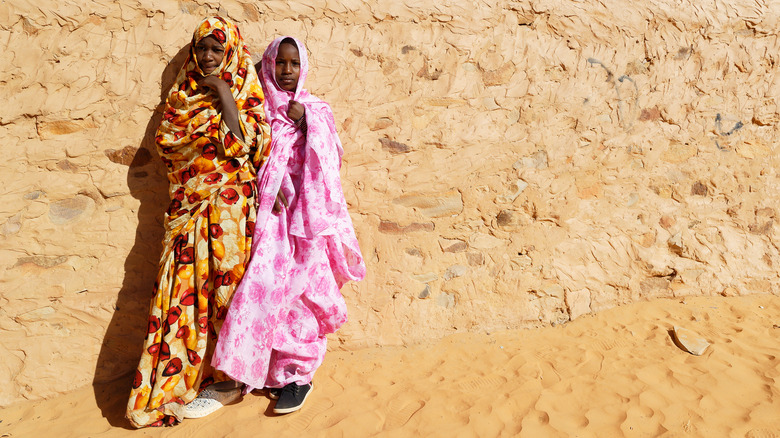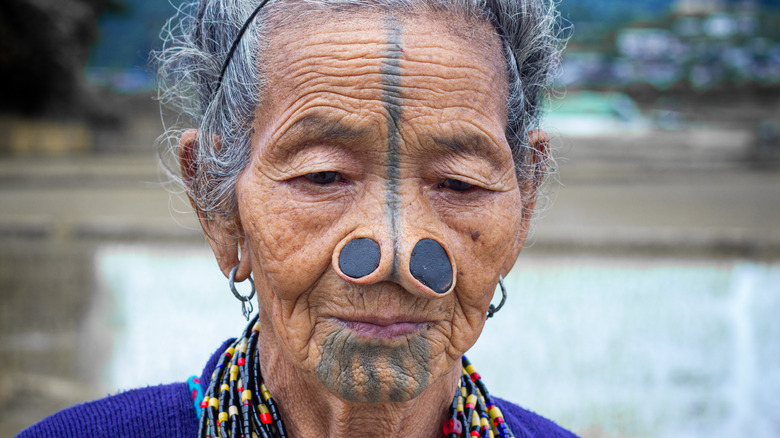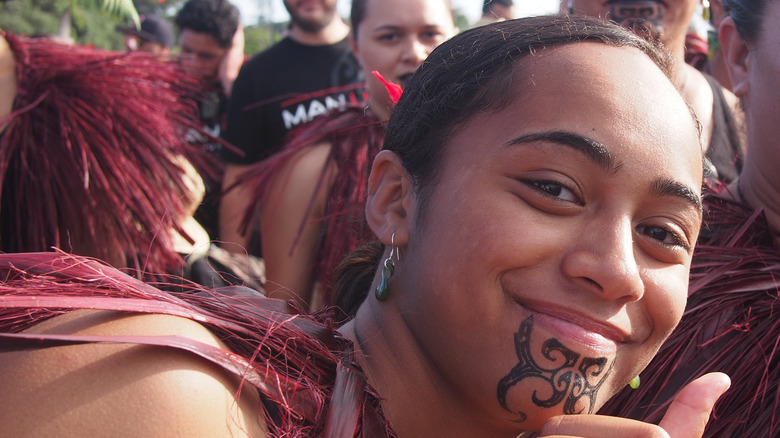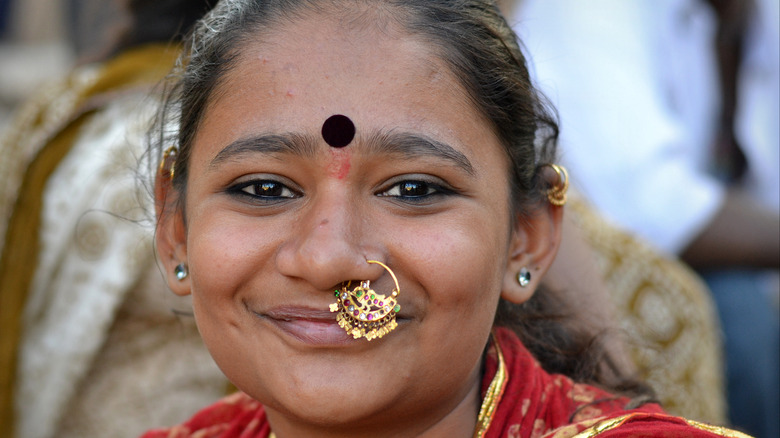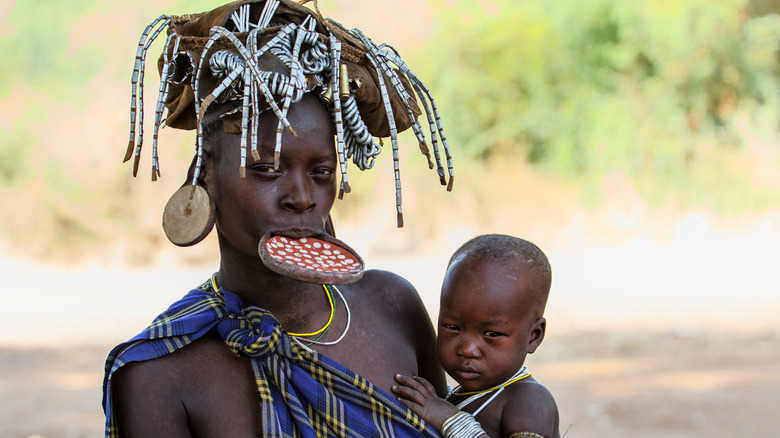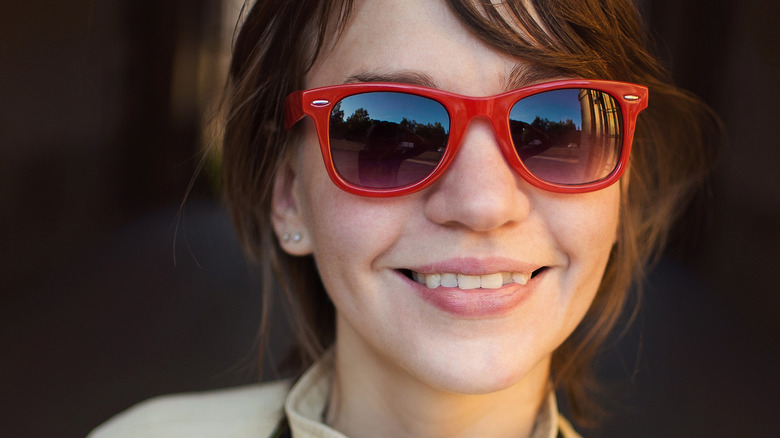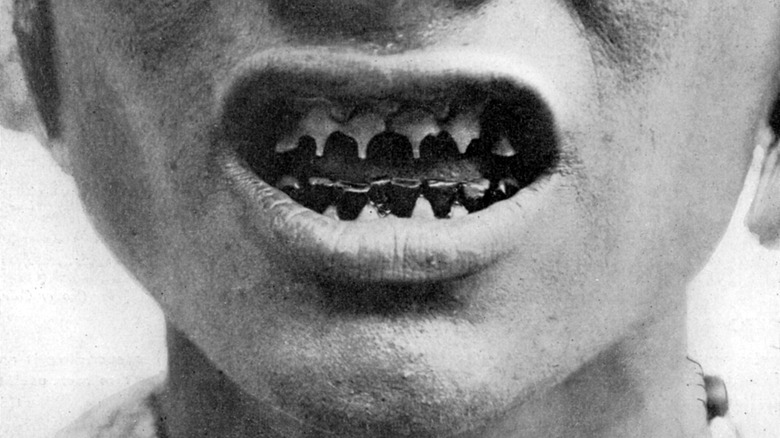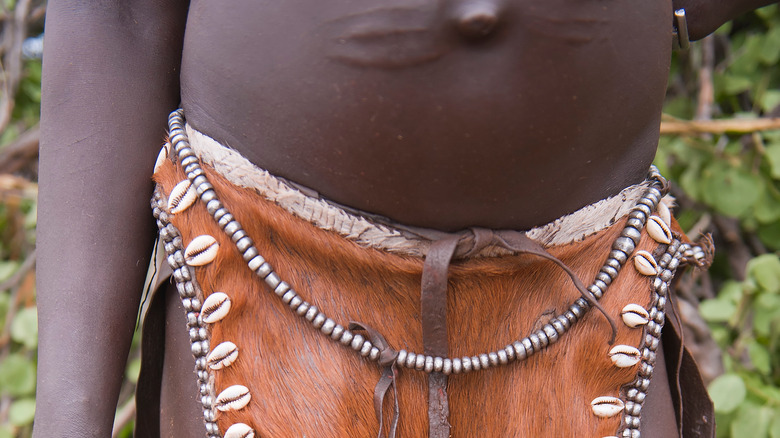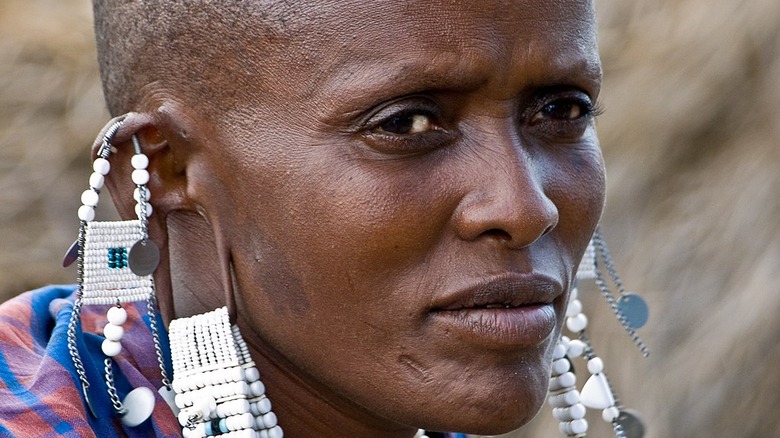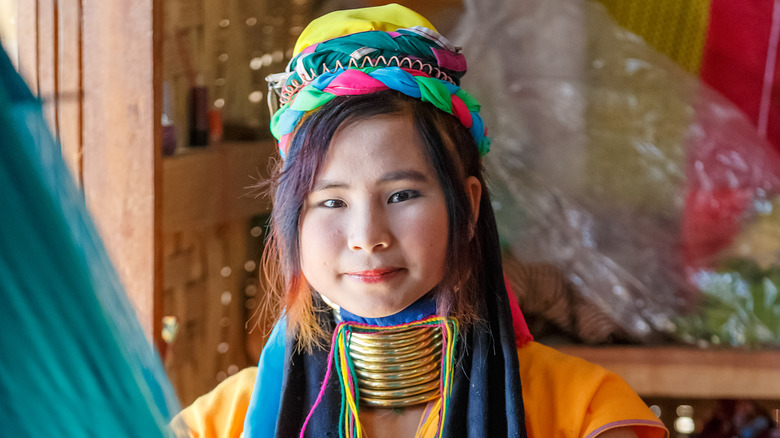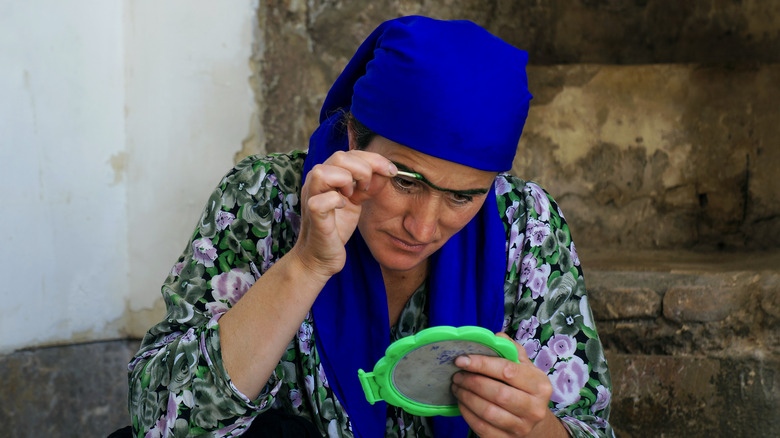Surprising Physical Traits Men Find Attractive Around The World
Evolutionary theory holds that it is precisely those physical traits that are consistent with — or outright demonstrative of — good health and the ability to procreate that tend to be perceived as more attractive by heterosexual members of the opposite sex (via National Geographic). This is true not only for humans but also for all species of animal that, like homo sapiens, have not yet suffered the indignity of becoming extinct. And while that could sound like a nice, pat explanation for why American heterosexual men would currently appear to have some preference for hourglass-shaped women (via Psychology Today), the fact is that not all men have such a preference — not all American men, and certainly not all men throughout the world.
As it turns out, every culture has been conditioned over the course of centuries to be vigilant in recognizing in members of the opposite sex a unique and specific set of physical "signifiers." These signifiers have everything to do with evolutionary advantages that consist of good health and robust fertility. The respective "signifiers" for any one culture can vary significantly from those of another culture, and they can shift over the course of generations. The best way to illustrate this is to examine some of the physical traits that heterosexual men find attractive in women in different cultures around the world.
Mauritanian men prize a robust female physique because it suggests she is not in danger of starving
Mauritania (formally, the Islamic Republic of Mauritania), is one of the larger countries on the African continent, with some of its land bordering the North Atlantic. Most of its borders, however, are shared with other African countries, including Senegal, Western Sahara, and Mali — and most of its land is flat and barren. Think: seemingly endless stretches of the Sahara plains. Think also: recurrent droughts, ongoing conflict with neighboring Mali, and few "income-generating opportunities" (via the U.S. Agency for International Development, or USAID). The fact is the people of Mauritania are no strangers to dealing with food insecurity — and this is a serious humanitarian issue that the U.S. government is attempting to address in cooperation with the U.N. and the governments of other nations.
As a result, being "thin" is not generally considered an appealing trait by Mauritanian men. In fact, quite the opposite, according to an article first published in Marie Claire and later aggregated by Brilio. "The stomach flab should cascade, the thighs should overlap, and the neck should have thick ripples of fat," according to one Mauritanian woman who runs a "camp" tasked with turning unacceptably slender girls and women into the sort of large-sized women that the men of Mauritania value, stretch marks be damned. In fact, stretch marks are highly prized in Mauritanian women, presumably because they suggest a woman is highly motivated.
The surprising reason nose plugs are so attractive in Northern India
In Northern India, in the state of Arunachal Pradesh, there is a small, indigenous tribe known as the Apatani who make their living fishing and farming (via the Yoair Blog). To the extent this required the Apatani to engage in trade with other tribes, it also exposed female Apatani to ogling by men visiting from other tribes. But ogling was hardly the only problem. Apparently, a number of Apatani women were actually abducted by visiting men from other tribes — before a tribal council came up with the idea of discouraging abductions by making their women unattractive (via The Vintage News). One way to accomplish that, it was decided, was by having the women insert large-size ornamental "plugs" into their nostrils.
The nose-plugging strategy worked so well that it became an Apatani tradition. What no one saw coming was the practice would come to grow on Apatani men. Women with nose plugs set the standard for sexual attractiveness in heterosexual women of the Apatani. Nose-plugging became such a fetishized practice, in fact, that it eventually came to be regarded as a burden on women; accordingly, in the 1970s, the practice was banned. However, Apatani women with nose plugs are considered privileged in the Apatani community, according to a 2020 academic paper published in the Rupkatha Journal on Interdisciplinary Studies in Humanities. The paper also stated, "The modern woman and girls ink themselves with false tattoos to signify their original identity."
Maori tribesmen love the look of facial tats on their women
Men of the Apatani tribe of Arunachal Pradesh in Northern India also introduced the donning of stark facial tattoos. As it turned out, the men of the Apatani grew accustomed to the facial tattoos (and nose plugs), seeing them as signifiers of an attractive female mate. Facial tattoos are considered very attractive by men of the indigenous Māori culture of New Zealand as well, but for a completely different reason.
In the Māori culture, facial tattoos (known as "moko" in Māori) are a tradition for both men and women and also a rite of passage (via New Zealand.com). Each moko is unique, reflecting personal and ancestral history, as well as eligibility to marry. The tradition, however, was for women to have theirs on their lips, chins, and throats — areas that are sometimes associated with sensuality. So, for a Māori man, seeing a woman with an impressive moko on her lips, chin, and/or throat not only tells the man that this is a marriageable woman, but it also gives him reason for his eyes to linger on these areas of her body. Is it any wonder that Māori men came to find these facial tats attractive?
Sexy piercings are attractive to many men outside the U.S.
Starting with the punk movement in the 1970s and '80s, body piercing in the United States became more popular, though still not a mainstream practice. But when Bodys Jewelry Reviews asked American men how they felt about piercings on women, they unanimously downvoted anything in the category of a "sexy" piercing, which is to say they downvoted lip, tongue, nose, nipple, and genital piercings. However, a research paper published in 2016 suggested that American women who love their sexy piercings need not concern themselves with how American men feel — particularly when so many men from other cultures find these piercings attractive (via Wiley Online Library).
For example, men from a number of different African tribes consider lip piercings and tongue piercings to be attractive. In addition, in Indian culture, it isn't unusual for a young woman to have her nose pierced in the hopes of making her look more beautiful and thus appear a better candidate for marriage (via Body Jewelry). In Italy, women are known to do a little neck-flirting with a dermal piercing placed just at the nape of her neck — perfect for a summer updo (via WildKlass Jewelry). In the U.K., it's become popular in recent years for women to sport a "smiley," which is a curved barbell-shaped adornment for the frenulum.
Stretched-out lips are attractive to men of the Mursi tribe of Ethiopia
In Ethiopia, it is traditional for women of several tribes, perhaps most notably the Mursi, to go through a lengthy and time-consuming process of lip-stretching. The process leaves them with what might appear as a lip stretched to the size of a dinner plate — all for the purpose of making themselves appear more attractive to the men of their tribes (via the Ethiopia Blog). Stretched lips, including the action by which the lips are stretched, is viewed by the tribal men as a signifier of beauty, femininity, and reproductive maturity. And the process begins as soon as a young girl comes of age (via Yen).
The stretching process is initiated with the placement of a cut into the young woman's lower lip by her mother or a mother figure from the community. A wooden plug or other object is inserted into the cut, holding the cut open as it heals. Thereafter, progressively larger objects are inserted into the gaping hole, with the goal being the insertion of a lip "plate," or, as it is known in the Mursi language, "dhebi a tugoin." In each case, it is up to the individual Mursi woman to determine how far she will go in stretching her lip. However, there is a cultural understanding that the further a woman's lip is stretched, the more "worthy" she is of a good marriage.
Japanese men love a snaggletooth
Straight, white teeth are highly prized in the United States, regardless of gender or sexual preference. However, a recent trend in Japan is for grown women to pay for dental work that deliberately makes their teeth appear crooked and their smiles, "snaggle-toothed" (which refers to overlapping teeth). The reason is that there is now apparently a demographic of Japanese men who are drawn to this particular look, which is known as "yaeba," according to Tofugu.
Tofugu posits that yaeba can make a woman look "cute, almost childlike, like when a kid's teeth aren't fully grown in yet." To put it another way, going to the dentist to get "yaeba" would appear to serve a purpose similar to having one's hair lightened to the blonde color they remember having as a child. Or going to the dermatologist for a dermal peel, the goal of which is to make one's skin glow more youthfully. In other words, the snaggle-toothed look can lend a youthfulness to the look of a grown Japanese woman.
For Bagobo men, there's nothing so attractive as a set of filed, blackened teeth
In the Philippines, men in the Bagobo ethnic group regard severely carved and blackened teeth as a sign of physical attractiveness in women. To achieve this look, a woman must subject herself to having her teeth filed down to needle-like points and then tinted black using a natural pigment such as charred bamboo or a powder found in the almond tree. The process is not only painful but involves "downtime," to borrow a phrase often used in the context of plastic surgery recovery. During this particular downtime, water is forbidden, as is eating anything sour (via Zee5.com).
Bagobo men are not alone in their preference for women with sharply modified teeth. The women of the Mantawai people of Indonesia, for example, are known for having their teeth shaped and filed down to appear like animal teeth (so, not as skinny as the Bagobo needle-teeth). In Vietnam, like in the Philippines, there are women who have their teeth sharpened and then colored black. However, in Vietnam, enamel is often used for the blackening. So, why do the men of these cultures find this look attractive? It has been suggested that the men may associate a woman's teeth with some of her less attractive personality traits, including romantic rage and jealousy. And for some of these men, the filing and darkening of a woman's teeth may represent a symbolic exorcism of such foibles.
In some Ethiopian tribes, the more scars she has, the more desirable a woman is
Most of us are familiar with the movie and television trope in which a man loves a woman who bears physical scars from her past and shows her just how much by kissing said scars and/or saying how much he loves them because they're part of her — the woman he loves — and represent how she came to be who she is. In certain Ethiopian tribes, namely the Bumi and the Omo, one gets the feeling that this is far more than a trope — it's a reality. In these tribes, men don't merely "accept" a woman with all of her scars. Rather, they seek out women who have had their bodies deliberately scarred. In these tribes, scarification is a practice meant to make women more desirable and attractive to men, according to Overland Ethiopia Tours.
Scarification involves the making of tiny cuts on the surface of the skin — in various patterns and designs — and then rubbing ash into the incisions. The ash causes irritation and inflammation. As a result, the healing process is interrupted, making scarring more likely, and that's a good thing for the men of the Bumi and the Omo. In their own personal bid for being found as attractive as possible, Bumi women have been known to go so far as to scarify their eyelids, cheekbones, and ribcages, among other parts of their bodies.
Long, stretched-out earlobes are considered attractive in various African tribes
Saggy earlobes are not a thing in the United States, unless by "thing" you mean something that plastic surgeons are in the business of fixing (via Williams Facial Surgery). It's been reported that in the U.S., saggy earlobes suggest the ravages of aging, among other things, which is pretty much the opposite of what a heterosexual young man would tend to be looking for in a prospective partner in baby-procreation. But in various African tribes, such as the Maasai, the Mursi, the Lahu, and the Karen-Padaung, women go out of their way to stretch their earlobes in the hopes of becoming more attractive to the men of their community (via the Orient Daily).
Stretched earlobes on a woman are signifiers to the men of these tribes that the woman is mature and of child-bearing age. In some of these cultures, stretched ears are also associated with wisdom, and in still others, the manner and extent to which a woman's earlobes are stretched helps to distinguish the women of one particular tribe from the women of another (via Two Feather Plugs).
A super-long neck adorned with metal rings is the definition of attractive in some cultures
Audrey Hepburn was a beautiful woman with a long neck. But in certain cultures, particularly certain Asian and African cultures, Hepburn's proportions might have been regarded as "basic" at best. That's because in these cultures, super-long necks are not only fetishized by men but also cultivated by women using extreme body-modification techniques (via History Daily). For example, women of the Kayan tribe in Myanmar are known to elongate their necks over the course of their entire lives by encircling their necks with metal rings and adding rings as their necks gradually elongate (via Al Jazeera).
Although the belief in these cultures is generally that "the longer the neck, the more beautiful the woman," neck elongation may have begun as a way to produce an ill-favored look, like nose-plugging and tooth-modification in some cultures. In other words, women were encouraged to don these neck-elongating rings to make them look less attractive to men from neighboring tribes. Another explanation posited that the neck rings were worn to protect women from having their necks slashed by a tiger, in the event of a tiger attack.
Tajikistani women sport unibrows
Over the past century, American female eyebrow culture has reversed itself too many times to count. At various times, women were expected to tweeze their eyebrows to the point of having to redraw them back on. Other times, women were encouraged to grow their eyebrows long and thick. Currently, the trend is for women to not only keep their eyebrows as long and thick as possible, but also to accentuate them still further with powders and pencils and even semi-permanent tattooing. It's not clear, however, whether and to what extent American eyebrow styles have been dictated by what men find attractive.
But the same can't be said of the eyebrow culture in Tajikistan, a landlocked nation in Central Asia where it's considered attractive for a woman to sport a unibrow. In Tajikistan, a unibrow is considered a mark of beauty (via women'sweb). "You see [the unibrow] on women and girls," according to The World. "Sometimes the unibrows are natural — black and bushy and ever elegant. But those who missed out on the unibrow gene use an herbal remedy to fake it."
As for why men find it attractive, it's possible that it is a signifier of "youth" (via the Anti Aging Beauty Zone), a trait that tends to be naturally and implicitly associated with fertility as well as the promise of many years of life expectancy to come.

